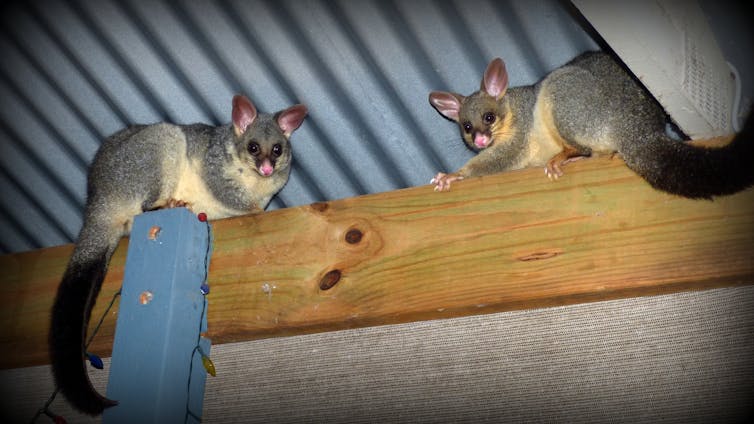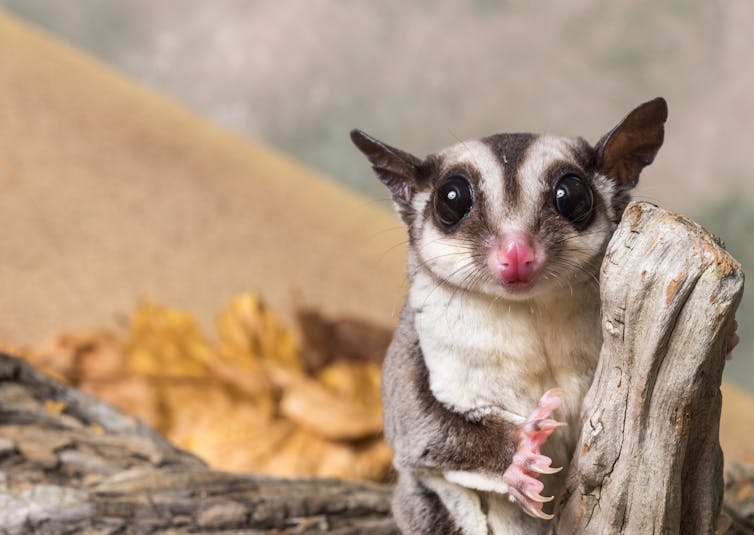if trees are cut down in the city, where will possums live?
- Written by Kylie Soanes, Postdoctoral Fellow, School of Ecosystem and Forest Sciences, The University of Melbourne
If trees are cut down in the city, where will possums live? - Millie, age 9, Sydney.
Hi Millie.
Thanks for your question. I worry about this too.
Trees are really important to possums in the city. Like lots of Australian animals, possums depend on hollows — a hole that forms in trees as they get older. Because possums are nocturnal (meaning they only come out at night), they need somewhere safe to curl up and sleep during the day. A nice cosy tree hollow is the perfect place.
Tree hollows are special because they take a long time to make. They usually happen when a tree gets injured and the place where it broke starts to rot away, eventually forming a hole. Most types of gum tree don’t even start making hollows until they’re more than 100 years old. Usually, the bigger the tree, the more hollows you’re likely to find.
Out in the bush, a possum might have lots of different trees and hollows to choose from. Some kinds of possum might have 12 different hollows – 12 bedrooms! Can you imagine?
But in the city, we don’t have as many big trees with hollows, so possums can’t be as picky about their bedrooms. And when a big old tree dies or is cut down, even if we plant a new one we might have to wait hundreds of years before it provides a good possum house. This means the possums have to look for somewhere else to live.
 People often find possums sleeping in their roof.
Shutterstock
People often find possums sleeping in their roof.
Shutterstock
Read more: Curious Kids: if our bodies are happy at 37℃, why do we feel so unhappy when it's too hot outside?
Other possum places in the city
Now, there are a few other places that possums might find in the city.
They want somewhere dark, dry and warm, and they don’t mind if they’re not supposed to be there.
That’s why people often find possums sleeping in their roof, in old pots in the garden, or even inside a barbecue!
Tiny possums can squeeze into even smaller places. Sugar gliders are sometimes found in electricity boxes, and feathertail gliders might nest in a drainpipe.
It’s amazing how resourceful animals can be! But these aren’t very safe places for possums to make a home. So there are two things we can do to help.
 Tiny possums can squeeze into even smaller places. Sugar gliders are sometimes found in electricity boxes.
Shutterstock
Tiny possums can squeeze into even smaller places. Sugar gliders are sometimes found in electricity boxes.
Shutterstock
1. Protect our city’s big trees
There aren’t many left, so every single tree is important. And it’s not just gum trees — lots of types of trees make hollows or provide food for native animals. Even dead trees!
Great big trees can get dangerous as they get older because if they drop branches or fall over they could hurt someone. Sometimes tree experts can use cables to keep the trees upright and safe, or only cut down the dangerous branches.
Or sometimes we can fence the area so that people don’t walk underneath. If a tree does have to be cut down, scientists came up with an idea to move the whole tree to a new spot — like a tree transplant! The tree can’t grow anymore, but it still has all the hollows possums and other animals need to make their homes.
2. Build new possum homes
There are lots of different ways to build new hollows for wildlife. Nest boxes (sometimes known as dreys) might be made out of wood, or old hollow logs, or even pot plant liners.
Sometimes local councils will use a chainsaw to carve holes into trees to make new homes for wildlife.
And other scientists are using 3D printers to make hollows that mimic the same shapes as real hollows (but we need to make sure the designs are safe).
City trees are so important. They help keep us cool in summer, make the air nice and fresh, and they’re nice to look at. Some of them have been here longer than the buildings.
So protecting trees in the city isn’t just good for possums. It’s good for humans, too.
Read more: Curious Kids: why does the sun's bright light make me sneeze?
Hello, Curious Kids! Have you got a question you’d like an expert to answer? Ask an adult to send your question to curiouskids@theconversation.edu.au
Authors: Kylie Soanes, Postdoctoral Fellow, School of Ecosystem and Forest Sciences, The University of Melbourne





